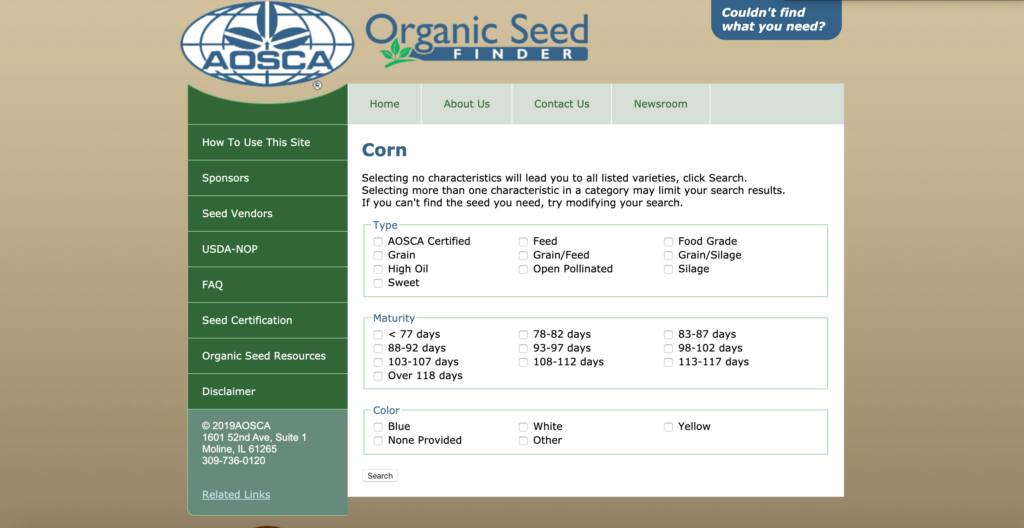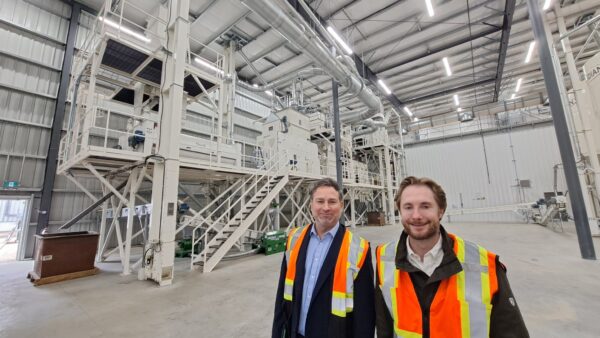What’s the availability of certified organic corn and soybean seed?
Organic products. They’ve been a huge hit with consumers. According to the Organic Consumers Association, sale of organic food has grown dramatically during the past decade, rising from $3 billion in 1997 to $50 billion in 2018.
But the big question for some farmers is: Where can you find organic seed, in particular, where do you find organic seed for corn and soybean production?
It’s known to be hard to find, but it’s not impossible. It’s like a good game of hide-and-seek with work being done behind the scenes to make it not-so-hard to find.
In 2012, in tandem with the organic seed industry, the Association of Official Seed Certifying Agencies (AOSCA) created a website to help alleviate some of the difficulties in finding organic seed across the United States: the Organic Seed Finder.
“We saw a need for organic growers to find their vendors,” says Chet Boruff, CEO of AOSCA. “Organic growers need to find the variety of seed to meet their need and the National Organic Program (NOP) requirements, or they at least need to make an attempt. In speaking with the Organic Seed Alliance (OSA), we asked the question — could we provide a service for the organic industry for vendors and customers to find one another?”
Boruff describes the Organic Seed Finder as a dating site for seed. This site is designed to find the perfect match for the type of seed you’re looking for, specifically, if you’re looking for organic corn and soybean seed.

“Until recently, more than half of the organic seed for corn and soybean grain used in the U.S. was imported, but that’s really changed in the past three years,” says Mac Ehrhardt, owner and manager of Albert Lea Seed. “It’s created a big opportunity for U.S. farmers. Specifically, U.S. organic farmers are filling in the gaps for imported grains that there were fraud issues with.”
Ehrhardt says the organic seed sector is on the “up and up.”
“Organic products are going to top $50 billion,” he says. “Organic corn and soybean grain are feed for dairy cows and poultry, which are the two biggest users. Acres are rising to meet those needs.”
However, the organic seed sector continues to be challenged by some of the loopholes within the U.S. Department of Agriculture’s (USDA) NOP rules. According to the NOP, organic seed must be used when commercially available. However, when the NOP was created in 2001, the organic seed sector was almost nonexistent, and is still working to meet demand.
The loophole: if a grower approaches three seed companies and asks for a variety of organic seed, and it isn’t found and he is able to provide proof of his search, the grower may use conventional, non-treated seed in place of certified organic seed.
As the owner of a company that has sold organic and conventional non-GMO seed since 1998, this is discouraging to Ehrhardt.
“The OSA continues to show organic seed usage is not as high as it could be,” he says. “It’s not necessarily about availability. The larger the operation, the less likely they are to use certified organic seed. The really big organic vegetable and organic corn and soybean producers are more likely to use conventional, non-treated seed.”
However, as co-chair of the Organic Committee for the American Seed Trade Association, Ehrhardt says that this is changing as years progress.
“There’s a lot more availability of organic corn seed, especially as the organic industry continues to grow,” he says. “While there will still be many organic acres in the U.S. planted to conventional, non-treated seed, there will still be plenty of acres grown of certified organic seed.”
Regional Differences, How We Can Help
One reason there’s plenty of acres grown to conventional, non-treated seed is based on regional availability of organic corn and soy seed.
Terry Hollifield, CEO of the Georgia Crop Improvement Association, says one reason they don’t see plenty of organic corn and soybean acres is because of the difficulties growing organic in the Southeast. Georgia Crop is an organic certifying agency accredited by the USDA NOP.
“The southeast has unique growing conditions, high temperatures and humidity, compared to the corn growing sections of the U.S.,” he says. “There are few varieties or organic corn and soy seed developed specifically for the Southeast.”
Hollifield says Georgia falls into an area where more growers opt to use conventional, non-treated seed as opposed to certified organic due to these issues. From the loophole in the NOP rule, he believes there will always be a catch-22.
“We ask growers to contact at least three seed companies to ask for organic seed varieties, but as long as they are allowed to use non-GMO, conventional seed, I don’t think there will ever be an adequate organic seed program,” he says.
However, Boruff hopes this is a solution that the Organic Seed Finder can provide.
“The site works so that you can set up parameters to find a certain organic variety — say white, food-grade corn, for example,” he says. “When you hit search, it shows you those vendors listed with that variety. Then, you can go into more details about the variety, and you can go to that vendor’s site to learn more.”
However, if it isn’t listed on the site, that doesn’t mean that variety isn’t available. Boruff says one of the downsides to the site is that not every organic seed vendor lists on the site.
Ehrhardt says one thing that might make vendors list more varieties on the Organic Seed Finder would be if the National Organic Standards Board made it a requirement to check the seed finder for organic varieties.
“In Europe, organic farmers are required to use a similar tool to the Seed Finder to look for varieties,” he says. “It’s doomed to a really low usage rate because it isn’t required by the USDA.”
Despite this, seed companies are excited about the growth of the organic marketplace.
“In 2018 there were an estimated 6.5 million acres of organic farmland in the U.S. That’s corn, that’s soybeans, that’s vegetables and more,” Ehrhardt says. “When it gets that big, seed companies are going to see a need for it!”
In the meantime, he says the organic sector continues to improve.
“We have several good companies growing good hybrid organic seed corn,” Ehrhardt says. “Organic alfalfa seed production remains a challenge, but we’re getting better at it, as well of a lot of organic small grains. It’s gotten attention of small- to medium-sized companies to get organic on their market list.
“Organic farmers have much better choices in terms of germplasm and seed than they had 10 years ago, and it’ll only get better.”
If you want to check out what organic seed is available, visit organicseedfinder.org












